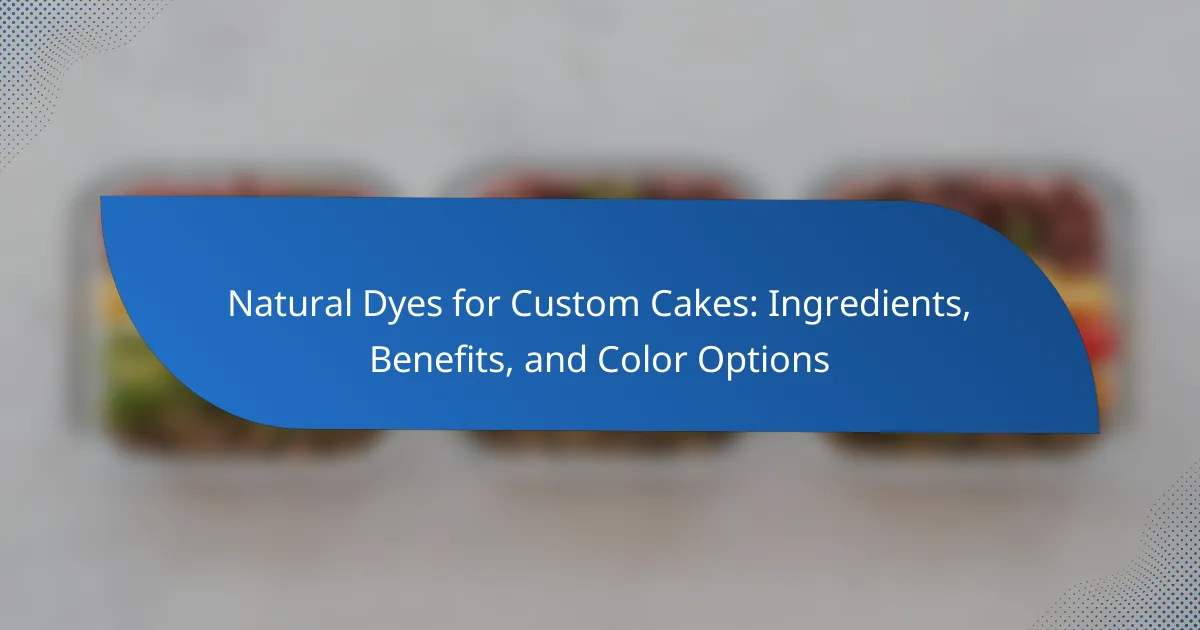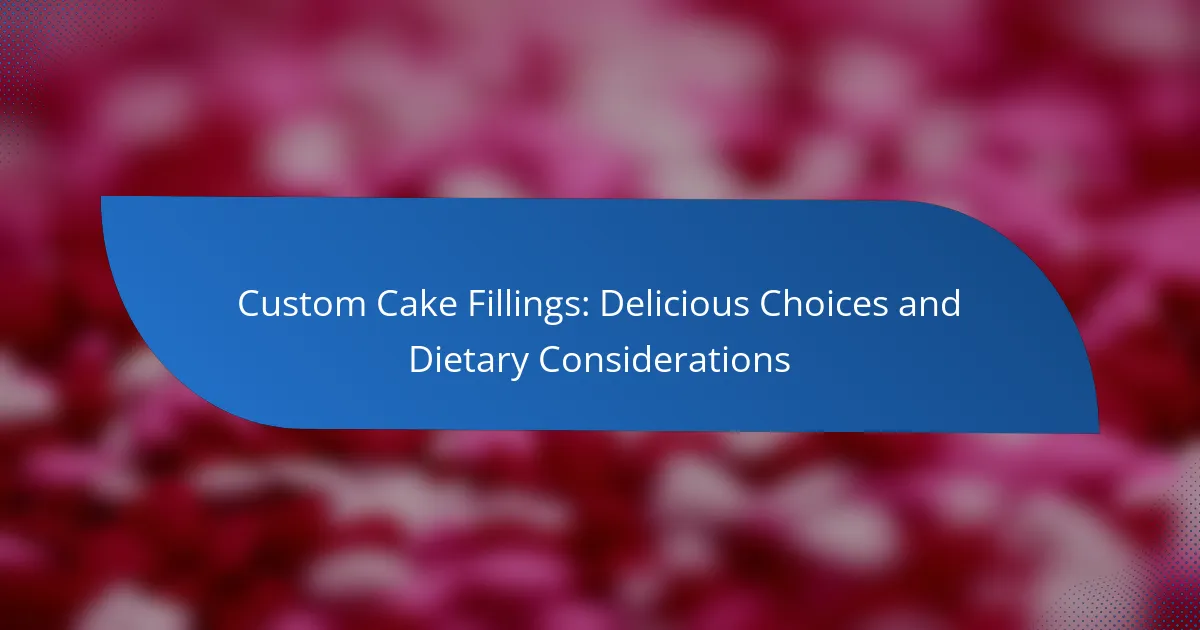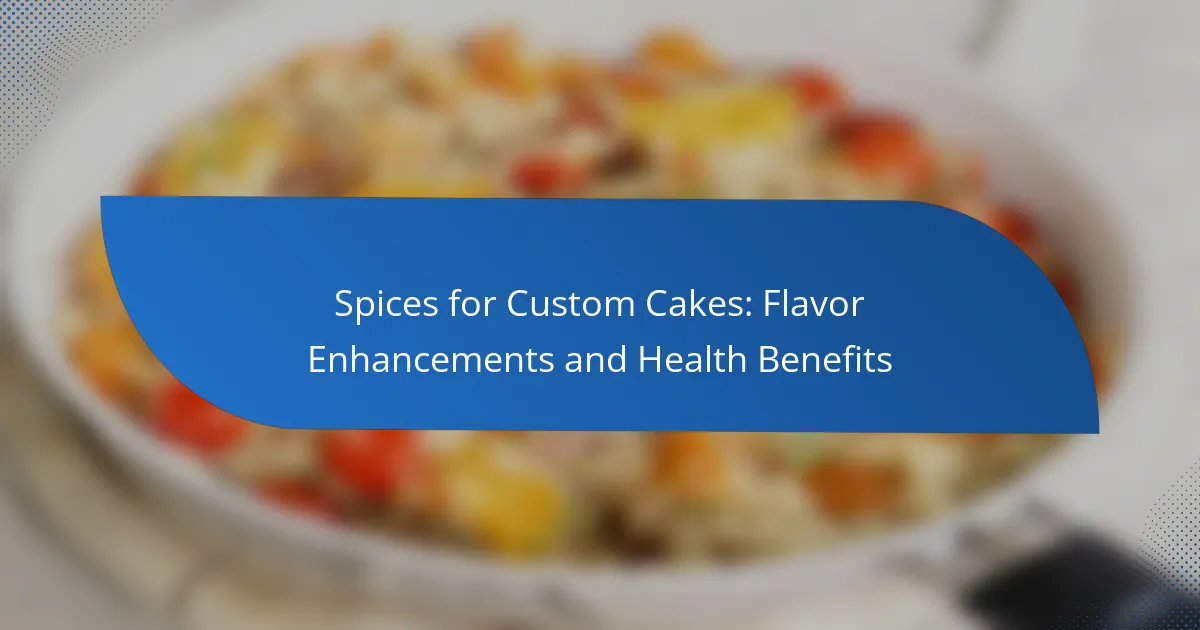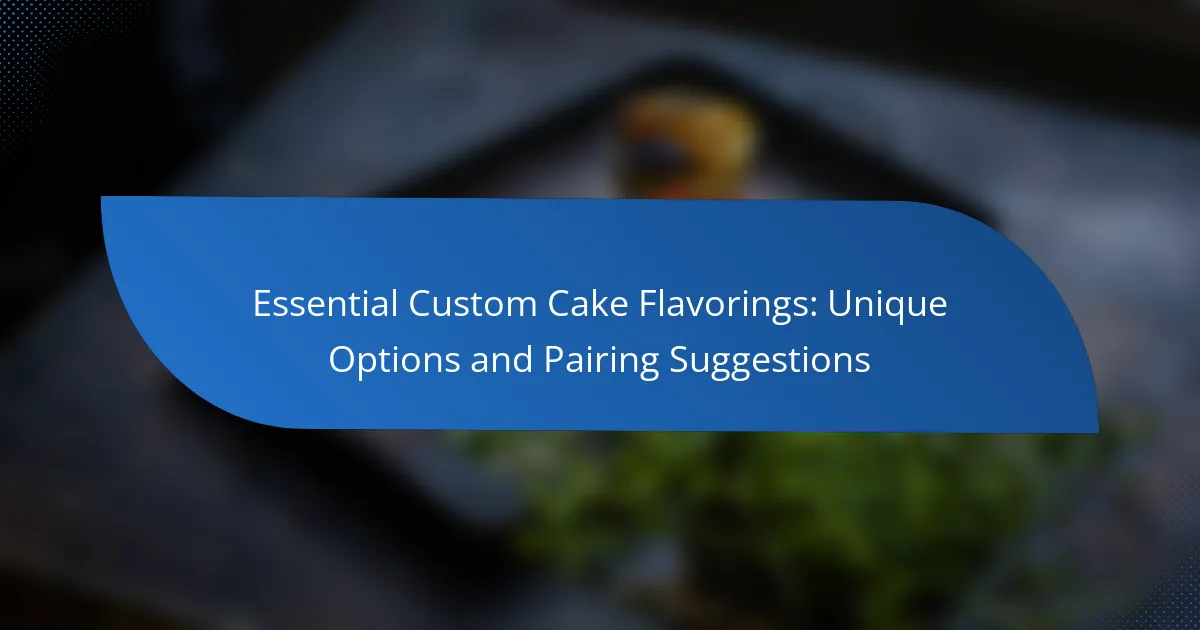Custom cake frostings are specialized icing options designed to enhance the flavor, texture, and visual appeal of cakes. This article explores popular varieties of custom cake frostings, including buttercream, cream cheese, fondant, ganache, and whipped cream, each offering unique characteristics that cater to different tastes and dietary preferences. The significance of texture in these frostings is also discussed, highlighting how it affects mouthfeel, appearance, and overall consumer satisfaction. Additionally, the article examines the impact of frosting thickness on adherence and presentation, providing insights into selecting the ideal frosting for various cake types.
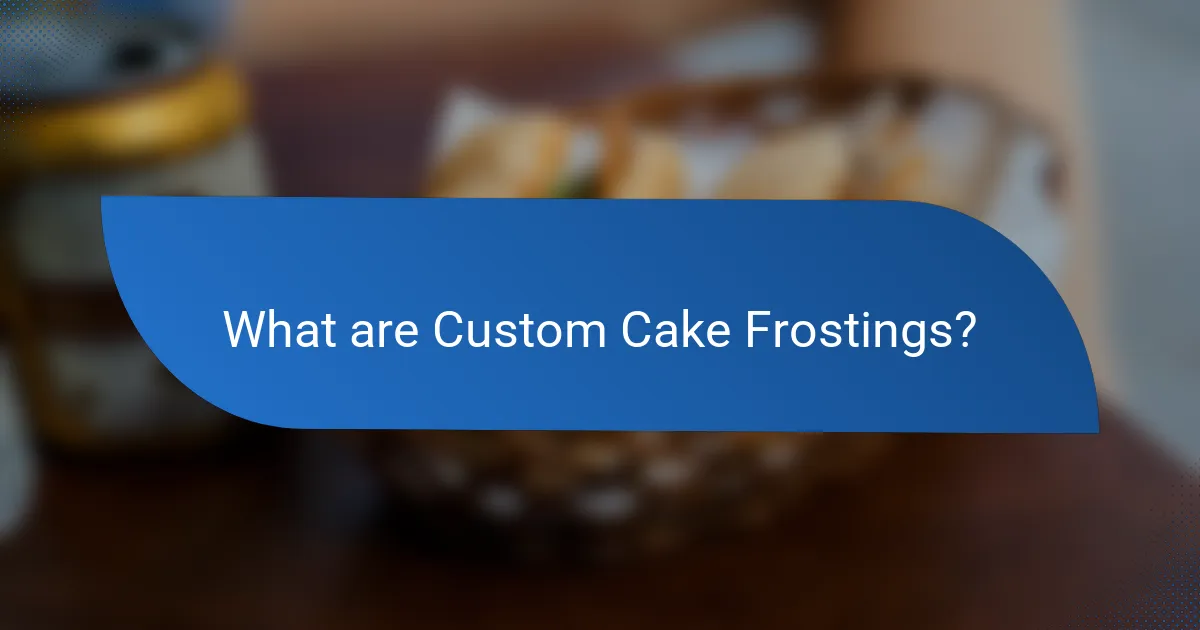
What are Custom Cake Frostings?
Custom cake frostings are specialized icing options tailored for cakes. They can be made from various ingredients, including butter, cream cheese, and fondant. These frostings allow for customization in flavor, color, and texture. Popular varieties include buttercream, ganache, and whipped cream. Each type offers distinct characteristics that enhance the cake’s overall appeal. For example, buttercream is creamy and easy to shape, while ganache provides a rich chocolate flavor. Custom frostings can also accommodate dietary preferences, such as vegan or gluten-free options. This versatility makes them a popular choice for celebrations and special occasions.
How do Custom Cake Frostings differ from regular frostings?
Custom cake frostings differ from regular frostings primarily in their personalization and flavor variety. Custom frostings are tailored to specific themes, occasions, or individual preferences. They often incorporate unique flavors, colors, and textures not typically found in standard frostings. Regular frostings usually follow conventional recipes, focusing on common flavors like vanilla or chocolate. Custom options may include exotic ingredients like matcha or lavender, enhancing the cake’s overall experience. Additionally, custom frostings can have varying consistencies, such as whipped, creamy, or even fondant-like textures, which are less common in regular frostings. This customization allows for a more creative and visually appealing presentation, aligning with specific cake designs.
What ingredients are typically used in Custom Cake Frostings?
Custom cake frostings typically use butter, powdered sugar, milk, and flavorings. Butter provides a creamy texture and rich flavor. Powdered sugar sweetens the frosting and helps achieve the desired consistency. Milk adjusts the frosting’s thickness and smoothness. Flavorings such as vanilla, chocolate, or fruit extracts enhance the taste profile. Additional ingredients can include cream cheese for tanginess or cocoa powder for chocolate flavor. These ingredients combine to create various frosting types, including buttercream, cream cheese frosting, and ganache.
What are the common preparation methods for Custom Cake Frostings?
Common preparation methods for custom cake frostings include creaming, whipping, and cooking.
Creaming involves mixing butter with sugar until light and fluffy. This method creates a smooth texture ideal for buttercream frostings. Whipping is used for frostings like whipped cream or meringue. It incorporates air to achieve a light and airy consistency. Cooking methods include making frostings like Swiss meringue or cooked flour frosting. These involve heating ingredients to achieve a specific texture and stability.
Each method contributes to the frosting’s final texture and flavor profile, ensuring versatility in cake decoration.
What are the benefits of using Custom Cake Frostings?
Custom cake frostings offer several benefits. They allow for personalization in flavor and design. Customization enhances the visual appeal of cakes for special occasions. Unique flavors can cater to individual preferences and dietary needs. Custom frostings can complement specific cake types, enhancing overall taste. They also provide an opportunity for creativity in cake decoration. According to a survey by the Cake Decorators Association, 85% of consumers prefer personalized cake options for celebrations. This indicates a strong demand for custom cake frostings in the market.
How do Custom Cake Frostings enhance the overall cake experience?
Custom cake frostings enhance the overall cake experience by adding unique flavors and textures. They provide an opportunity for personalization, allowing cakes to reflect individual tastes. Frostings can complement the cake’s flavor profile, creating a harmonious balance. For instance, a rich chocolate cake pairs well with a light vanilla buttercream. Different frosting types, such as cream cheese or ganache, introduce varied mouthfeel and sweetness levels. The visual appeal of custom frostings also elevates the cake’s presentation. A well-decorated cake can enhance the celebratory aspect of occasions. Studies show that aesthetics significantly influence taste perception. Overall, custom frostings play a crucial role in making cakes more enjoyable and memorable.
What role do Custom Cake Frostings play in cake decoration?
Custom cake frostings serve as a crucial element in cake decoration. They enhance the visual appeal of cakes through color and texture. Frostings can create different finishes, from smooth to textured, influencing the overall design. They also add flavor, complementing the cake’s taste profile. Customization allows for unique designs tailored to themes or occasions. Specific types of frostings, like buttercream or fondant, offer distinct aesthetic qualities. The choice of frosting impacts the cake’s mouthfeel and experience. Overall, custom cake frostings are essential for both decoration and flavor enhancement.
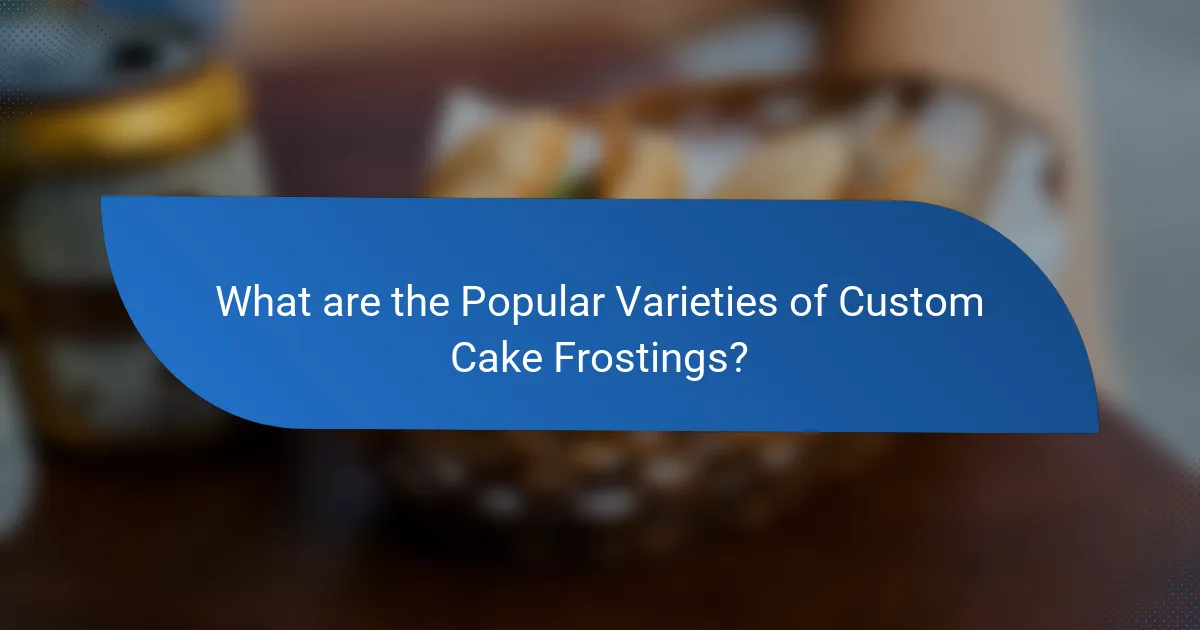
What are the Popular Varieties of Custom Cake Frostings?
Popular varieties of custom cake frostings include buttercream, cream cheese, fondant, ganache, and whipped cream. Buttercream is a classic choice known for its creamy texture and versatility. It can be flavored in various ways, such as vanilla, chocolate, or fruit. Cream cheese frosting offers a tangy flavor, making it ideal for red velvet or carrot cakes. Fondant provides a smooth, polished finish, often used for decorative cakes. Ganache, made from chocolate and cream, adds richness and can be poured or whipped. Whipped cream is light and airy, suitable for fresh fruit cakes. Each frosting type enhances the overall flavor and presentation of custom cakes.
What are the main types of Custom Cake Frostings available?
The main types of custom cake frostings available include buttercream, cream cheese, fondant, ganache, and whipped cream. Buttercream is a popular choice due to its creamy texture and versatility in flavors. Cream cheese frosting offers a tangy flavor, making it ideal for carrot and red velvet cakes. Fondant provides a smooth finish and is often used for intricate decorations. Ganache is a rich chocolate option that adds a luxurious touch to cakes. Whipped cream is light and airy, suitable for a fresh, less sweet topping. Each type serves a specific purpose and enhances the overall cake experience.
How does Buttercream differ from Cream Cheese Frosting?
Buttercream and cream cheese frosting differ primarily in their main ingredients and flavor profiles. Buttercream is primarily made from butter and powdered sugar, resulting in a sweet and rich flavor. It has a smooth and creamy texture, making it easy to spread and pipe. In contrast, cream cheese frosting incorporates cream cheese along with butter and sugar, giving it a tangy flavor. This tanginess balances the sweetness, creating a more complex taste. Additionally, cream cheese frosting tends to be slightly denser than buttercream due to the cream cheese’s consistency. Both frostings are popular for cakes, but their distinct taste and texture make them suitable for different types of desserts.
What unique characteristics do Ganache and Fondant have?
Ganache is a rich mixture of chocolate and cream. It has a smooth, glossy texture. Ganache can be poured or whipped, depending on its consistency. It is often used as a filling or icing for cakes. Fondant is a pliable sugar dough used for covering cakes. It creates a smooth, polished finish. Fondant can be molded into shapes and figures. It is less sweet than ganache and has a chewy texture. Both ganache and fondant serve different aesthetic and taste purposes in cake decoration.
What flavors are commonly used in Custom Cake Frostings?
Common flavors used in custom cake frostings include vanilla, chocolate, and cream cheese. Vanilla is a classic choice, providing a smooth and sweet taste. Chocolate frosting offers a rich and indulgent flavor, often made with cocoa powder or melted chocolate. Cream cheese frosting adds a tangy note, enhancing the sweetness of cakes. Other popular flavors are buttercream, which is versatile and can be flavored with various extracts, and fruit flavors like strawberry or lemon, which provide a refreshing twist. Nut-based frostings, such as almond or hazelnut, are also favored for their unique taste. Each flavor can be customized further with additional ingredients like spices or liqueurs for a distinctive profile.
How do flavor profiles affect the choice of frosting for cakes?
Flavor profiles significantly influence the choice of frosting for cakes. Different cake flavors require complementary frostings to enhance overall taste. For instance, a rich chocolate cake pairs well with chocolate or vanilla buttercream. This combination balances sweetness and depth. Conversely, a citrus-flavored cake, like lemon, benefits from a light, tangy frosting such as cream cheese or whipped cream. These frostings add brightness and contrast to the cake’s flavor. Additionally, flavor profiles can dictate texture preferences. A dense cake may call for a thicker frosting to maintain stability. In contrast, a light sponge cake often suits a fluffier, airy frosting. Ultimately, harmonizing flavors and textures creates a more enjoyable dessert experience.
What are some innovative flavor combinations for Custom Cake Frostings?
Innovative flavor combinations for custom cake frostings include lavender honey, matcha white chocolate, and salted caramel mocha. Lavender honey offers a floral sweetness, enhancing traditional vanilla bases. Matcha white chocolate combines earthy matcha with creamy white chocolate for a unique twist. Salted caramel mocha merges rich coffee flavors with sweet caramel and a hint of salt, creating depth. Other combinations like lemon basil, chocolate chili, and coconut lime also stand out. Each of these pairings introduces distinct taste profiles, appealing to diverse palates. These innovative flavors are often used in gourmet bakeries to attract customers seeking unique dessert experiences.

How do Textures Influence Custom Cake Frostings?
Textures significantly influence custom cake frostings by affecting mouthfeel, appearance, and flavor perception. Smooth frostings provide a creamy texture that enhances the richness of flavors. Conversely, textured frostings, such as those with nuts or sprinkles, add a crunchy element that contrasts with the softness of cake.
The thickness of frosting also impacts how it adheres to the cake. Thicker frostings can create a more substantial layer, while thinner frostings may allow for a more delicate finish. Additionally, the texture can influence the visual appeal of the cake. A rough or swirled texture can create an artistic look, while a smooth finish offers a polished appearance.
Research indicates that texture plays a crucial role in consumer preferences. A study published in the “Journal of Texture Studies” found that texture significantly affects overall satisfaction with food products. Thus, choosing the right texture for custom cake frostings is essential for enhancing the overall cake experience.
What are the different textures of Custom Cake Frostings?
Custom cake frostings can have various textures, including smooth, creamy, fluffy, and gritty. Smooth frostings, like fondant, create a sleek appearance on cakes. Creamy frostings, such as buttercream, provide a rich and soft texture. Fluffy frostings, like whipped cream, are light and airy, enhancing the cake’s overall delicacy. Gritty textures may occur in frostings with added ingredients like crushed cookies or nuts. Each texture impacts the cake’s mouthfeel and visual appeal.
How does the texture impact the taste and presentation of the cake?
Texture significantly impacts the taste and presentation of a cake. A smooth, velvety texture enhances the perception of flavors, making them more enjoyable. Conversely, a dry or crumbly texture can detract from the overall taste experience. Additionally, texture influences how frosting adheres to the cake, affecting its visual appeal. For example, a light and airy frosting can create an elegant look, while a thick, rich frosting adds a more substantial appearance. The contrast between cake and frosting textures can also enhance the overall experience. Cakes with varied textures, such as a moist base paired with a crunchy topping, create a more complex flavor profile. This complexity can elevate the cake’s presentation and make it more inviting.
What techniques can be used to achieve various frosting textures?
Techniques to achieve various frosting textures include piping, spreading, and combing. Piping creates intricate designs and textures using different piping tips. Spreading results in smooth or rustic finishes depending on the tool used. Combing involves dragging a tool through the frosting for a striped effect. Additional techniques include swirling for a marbled look and texturing with a spatula for peaks and valleys. Each method allows for unique visual and tactile experiences. These techniques are commonly used in cake decorating to enhance aesthetic appeal.
Why is texture important in Custom Cake Frostings?
Texture is important in custom cake frostings because it affects the overall eating experience. The right texture can enhance flavor perception and mouthfeel. For instance, a smooth frosting provides a creamy sensation, while a whipped frosting offers lightness. Different textures can also create visual appeal, enticing consumers. Certain textures, like crunchy or silky, can complement specific cake flavors. Research shows that texture influences consumer preferences significantly. A study by the Institute of Food Technologists found that texture is a key factor in food acceptance. Therefore, achieving the desired texture is crucial for customer satisfaction in custom cakes.
How do different textures complement specific cake types?
Different textures enhance specific cake types by providing contrast and balance. For example, a dense chocolate cake benefits from a light, airy frosting. This contrast creates a pleasing mouthfeel. Conversely, a sponge cake pairs well with a richer, creamier frosting. The creamy texture adds moisture and depth to the light cake. Additionally, textured frostings, like those with nuts or sprinkles, add visual interest and crunch. This complements the softness of cakes like vanilla or lemon. Each texture plays a role in the overall tasting experience. The right combination can elevate the flavors and enjoyment of the cake.
What are some tips for achieving the perfect frosting texture?
To achieve the perfect frosting texture, start with room temperature ingredients. This ensures better mixing and smoother results. Use high-quality butter for a creamy base. Beat the butter thoroughly before adding sugar to achieve a light and fluffy consistency. Gradually add powdered sugar to avoid clumping. Incorporate milk or cream slowly to reach desired consistency. Whip the frosting for several minutes to incorporate air. This increases lightness and spreadability. For a glossy finish, consider adding a small amount of corn syrup. These techniques are commonly used by professional bakers to create appealing frosting textures.
What are the best practices for customizing Cake Frostings?
To customize cake frostings effectively, start with a base recipe that suits your cake type. Use butter or cream cheese for richness. Incorporate flavor extracts like vanilla, almond, or citrus to enhance taste. Adjust sweetness by varying powdered sugar amounts. For texture, consider adding cream for a smoother finish or cocoa powder for chocolate frostings. Experiment with food colorings to achieve desired hues. Always taste as you go to ensure balance. For stability, add meringue powder if needed, especially in warm conditions. These practices ensure a personalized and delicious frosting tailored to your preferences.
Custom cake frostings are specialized icing options that enhance the flavor, texture, and visual appeal of cakes for various occasions. This article covers popular varieties of custom cake frostings, including buttercream, cream cheese, ganache, and fondant, detailing their unique characteristics and preparation methods. It also explores the importance of texture and flavor profiles in creating customized frostings, highlighting innovative combinations and best practices for achieving the perfect frosting consistency. Overall, custom cake frostings play a crucial role in cake decoration and personalization, catering to diverse tastes and dietary preferences.
